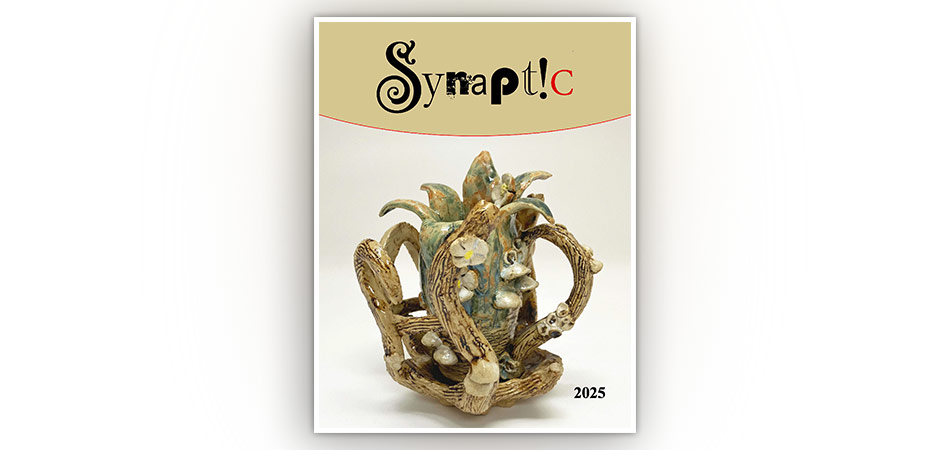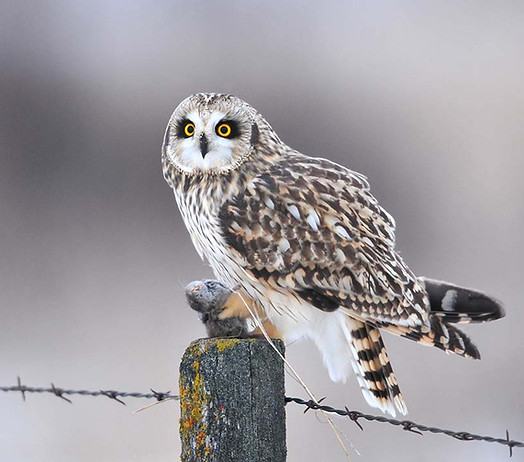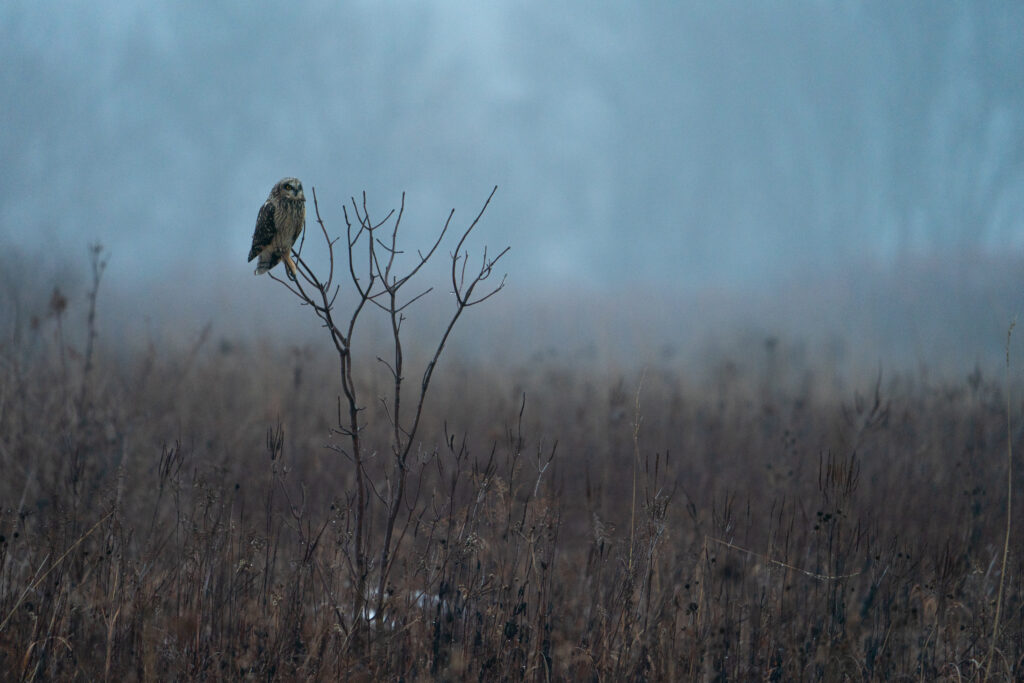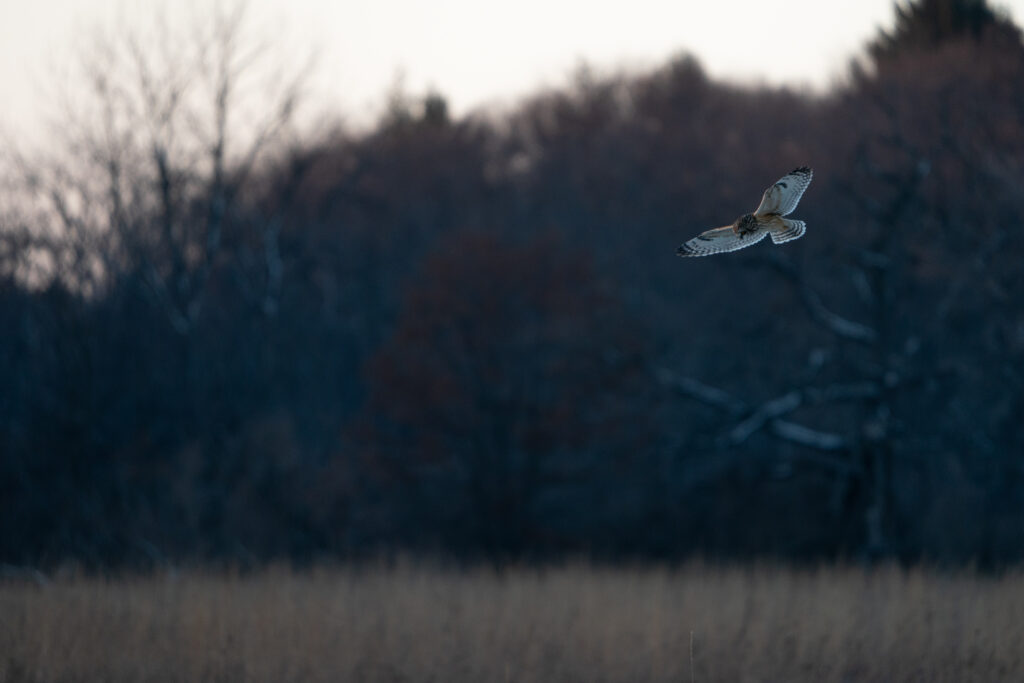
Dark Blue Owls
By Kayla Lindquist ’25
LAS 410: Ecotones
Kayla caught our attention immediately with her beginning poem, followed by her captivating and conversational narrative addressed directly to us as readers. She enchanted us with her knowledge of short-eared owls and photography as well as her distinctive voice, descriptive word choice, sense of humor, and integration of pithy epigraphs and distinctive visuals with memorable captions. Her connection to the short-eared owls and their landscape provides a model for the benefits and delights of connecting to nature.
-Dr. Mary Stark
in my mind, my thoughts were shallow
like the vole’s
who crawled below the grass searching for its home
in silence
i walked slowly as the sun crept behind the trees
the colors left the land
with guidance
it’s as if it was planned when all eight owls took flight
with their wings that scanned the landscape like a deft painter’s hand
their silence is impossible to understand
free as their wings cut through the wind and soared over the prairie’s expanse
it was only this moment and then they were gone
i haven’t seen them since.
 A short-eared owl (Asio flammeus) with its prey. The species epithet flammeus is Latin for fiery or flame-colored, referring to the rusty brown color of the bird, which is more noticeable when backlit (Hawk Mountain). Notice the owl’s “eyeliner and/or mascara” around its eyes. Photo reprinted with permission from Kurt Lindsay.
A short-eared owl (Asio flammeus) with its prey. The species epithet flammeus is Latin for fiery or flame-colored, referring to the rusty brown color of the bird, which is more noticeable when backlit (Hawk Mountain). Notice the owl’s “eyeliner and/or mascara” around its eyes. Photo reprinted with permission from Kurt Lindsay.
People often ask me what my favorite bird is. The question repulses me; how could I possibly just choose one? And yet I always answer: the Short-Eared Owl.
Otherwise known as the grass owl, this species spends the summer up in the Arctic tundra and often migrates south for the winter, sometimes traveling as far as Southern California. In my experience, they favor wet prairies speckled with wetlands and slithering streams. Typically, they choose to inhabit expansive landscapes as they are used to the open arctic and prefer a lush food supply of small mammals, rodents, birds, and sometimes even bats (Short-Eared Owls). The prey populations will need to sustain multiple owls, and possibly their young, as well as many other species. They nest on the ground of grasslands and prairies in groups and create a bowl-shaped nest (Short-Eared Owls). Being a ground nester in the Midwest is fairly unique, especially for owls, but this decision is linked to their advantageous camouflage and a preference for vast grassland ecosystems (All About Birds). Once they are sitting still amidst the tufty grasses, they are almost impossible to see. I have once walked right up to a colony of eight or so individuals and could not see them a couple of feet in front of me until they burst up into the dark blue sky and hovered above me for a moment, likely in confusion or frustration, then oriented themselves before scattering through the air. That was a pretty magical moment and also my first real sighting of them.
Behaviorally, this interesting owl call sounds akin to a cat yowl. I have heard its unique barking call “keooooow/KEoww” bounce throughout the heavy dusk air many times. They also frequently participate in what’s called “aerial battles” among themselves or other species such as the Northern Harrier. Usually, it is initiated by an argument over prey or territory. The birds then chase and charge each other in flight and make acrobatic displays as they avoid each other’s sharp talons. Short-Eared Owls may be small, but they are wise and mighty.
So why are Short-Eared Owls my favorite?
Besides their loveable face and fascinating biology, it probably has a lot to do with the experiences I have had with them. Every Christmas break I make several trips to a local wetland preserve called “Calvin and Sophia Ferguson Forest Preserve” or Ferguson for short. This property was once a farm but has been restored to wetland and prairie habitat. It is 529 acres, located at the confluence of two rivers (Sugar and Pecatonica), which you can walk alongside on the trail, and provides rich habitat for over 150 species of birds (winnebagoforest.org). Ferguson is one of my favorite places to visit and provides a restorative outdoor experience after the fall semester. Being so open and under-visited, it is easy to forget I’m in Northern Illinois when I’m hiding with my camera in the middle of the prairie.

Historically, the typical visit requires a fast-paced hike towards the western section of the preserve. From there I scope out the horizon line, searching for little white “butterflies” flitting in the distance. If nothing then I scan the willow trees and scattered shrubs as they often hunt from the tops of willows or young scraggly oaks. However, the place I most consistently see them is on top of the wood duck or kestrel nesting boxes. Not only are they a reliable and sturdy perch on windy days, but the flat top of the wooden box provides a nice dinner plate as the owls eat their breakfast. After finding the main roosting sites of the owls and understanding their hunting dynamics, I normally just choose a promising spot in the middle of the prairie and hope for the best. This is because these owls are by no means acclimated to human visitors. They are extremely shy, and I’m sure even my weary presence whilst sitting on the ground can be enough to deter them from coming anywhere within a photographable range. Sitting still allows the birds to become more relaxed over time and eventually begin to accept me as they become engrossed in their sundown hunting spree.
Over the couple of years I have participated in this new tradition, I have learned that the owls will take advantage of warm days, just as humans will. They don’t want to hunt in the freezing cold, precipitation, and wind because not only is it uncomfortable for them, but it’s also uncomfortable for their prey too. Those days are good for rest and house cleaning, but not so much for grocery shopping or yard work. There are certainly still critters stirring about in the landscape, but it is far diminished during such brutal conditions. This is good news for me, because it means less time waiting for a photogenic fly-by when my fingers are numb and my toes are screaming in pain. So now I prioritize the more pleasant days that follow a stretch of less-than-ideal weather, as typically those garner the best results and the most action.
I can’t even begin to describe the beauty as the setting sun ignites the landscape with a glowing orange sheen that illuminates the edges of the Indiangrass and Goldenrod and sends sparkles shimmering across the surfaces of the half-frozen ponds and abandoned channelized streams. Not to mention the sprawling wolf oak limbs in the distance, which look good in the background of the very delicate, agile wing beats of the Short-Eared Owls. This is the main way I set this species apart from Northern Harriers; they look like a moth or butterfly as they float over the prairie, and they make flying look so easy. But this calming appreciation I have of their flight patterns and aesthetics is likely not reciprocated by the tiny mice and voles, as the last thing they commonly see is the flash of the owl’s huge, bright yellow eyes and the sharp talons coming right for their face. Either that, or nothing at all, depending on the angle of attack. I am grateful indeed that I can have an artistic appreciation, rather than the fearful one. It also helps me to respect the bravery of our rarely recognized mammal kin that hide underground, beneath the snow layer, and in the brush.
While I do have a couple decent images of the birds, I have left more times with an empty SD card than a full one. It is no easy task to photograph these birds in this setting; contrary to parks that receive heavy human traffic, the owls at Ferguson have plenty of space and want nothing to do with people. However, it is not only the owls that make the experience worth it. It’s also the herds of deer that decorate the tree line. It’s also the captivating seed pods of the swamp mallow, glowing like lanterns in the setting sun or like chalices overflowing with light. It’s also the kestrels, Northern Shrikes, eagles, sparrows, and the harriers that keep me very much entertained. It’s also the colors in the landscape, during the golden and blue hours. And last but not least, the long walk back to the car under the moonlight as the coyotes initiate their chorus of howls and yips and I’m left to wonder about all the animate rustlings in the vegetation around me. While daunting, having only the moonlight as a guide, I have walked the meandering trail many times and always with company. I remind myself of the bravery of the deer mice, foraging for seeds right under the nose of some of nature’s most adept hunters. At least I don’t have that to contend with.
Now that you understand more about the owls and the experiences I have had whilst photographing them, you may relate more to my poem “Dark Blue Owls.” The owls provide this enchanting experience in nature, which is even more fun when shared with others. To me, the owls tell their own poem of resilience, patience, diligence, and community. They are becoming a less and less common sight as their habitat shrinks and becomes more fragmented, and as humans become interested in other activities. These owls take part in population control and add a lot of excitement to the ecosystems in which they live. They are also an avenue for humans looking to connect with nature, as spotting them requires focus and attention as well as much learning about habitat dynamics and paying attention to the seasons/weather. It also means pushing yourself out of your comfort zone in order to get an authentic view of these beautiful birds. The landscape too is a poem of impermanence, mutuality, and reciprocity. My time photographing and learning about the ecology of these owls has certainly led me to form a deeper connection to not only Ferguson and my bioregion, but nature itself. They are, to me, one of the best examples of how photography is a bountiful tool of nature connection mentoring as it requires us to be totally focused, present, and immersed in the more-than-human world always present around us. And poetry, as well, works as a tool of reflection and storytelling as we make sense of these sensorial encounters and adventures. With these two tools, the separation between us and the earth disappears. Every winter when I return to my sit-spot I am reunited with the facts that life is short and unpredictable, nature provides many gifts, and I remember to realign my thoughts and attention to things that truly matter to me. It is also the transition from school, work, and society back into the natural community, which I think I favor more.
To end, I am full of gratitude that my mom has taken on this adventure with me every year and faced the brisk two-mile hike to the most promising owl habitat. I have also spent many nights there with my photographer friend and mentor Bryan who has taught me a thing or twenty-two about wildlife photography (https://www.bryanholliday.com/). I also thank the Short-Eared Owls and the other organisms for reminding me where I am and who I am.
“Nature is not a place to visit, nature is who we are.”
– Ada Limón, You Are Here
 A short-eared owl perched on an oak sapling in a misty cold fog.
A short-eared owl perched on an oak sapling in a misty cold fog.
 A hovering short-eared owl spanning the grasses below for movement, right before making a sudden dive.
A hovering short-eared owl spanning the grasses below for movement, right before making a sudden dive.
Works Cited
All photos are mine unless otherwise stated.
“Bryan Holliday Photography.” Bryan Holliday Photography, www.bryanholliday.com/. Accessed 15 Jan. 2025.
“Ferguson.” Winnebago Forest, www.winnebagoforest.org/items/ferguson. Accessed 15 Jan. 2025.
Kurt Lindsay (First photo)
Limón, Ada. You Are Here. Milkweed Editions, 2022.
“Short-Eared Owl.” Audubon, 7 Dec. 2024, www.audubon.org/field-guide/bird/short-eared-owl#:~:text=Mostly%20rodents.,gophers%3B%20rarely%20bats%2C%20muskrats.
“Short-Eared Owl.” Hawk Mountain Sanctuary, www.hawkmountain.org/raptors/short-eared-owl#:~:tex t=The%20genus%20name%20Asio%20is,the%20long%2Deared%20owl). Accessed 15 Jan. 2025.
“Short-Eared Owl Life History, All about Birds, Cornell Lab of Ornithology.” All About Birds, Cornell Lab of Ornithology, www.allaboutbirds.org/guide/Short-eared_Owl/lifehistory.